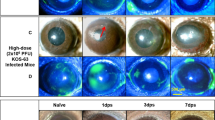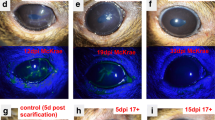Summary
In animal models, spread of herpes simplex virus type 1 (HSV-1) from epithelial replication sites to the peripheral and central nervous system is known from analysis of individually dissected tissues. To examine virus spread in undissociated tissues, corneas of adult mice were inoculated with HSV-1. After 1 to 13 days groups of mice were perfused with formalin, and decalcified blocks of head and neck were embedded in paraffin. At intervals, serial sections were screened for HSV antigen. On days 1 and 2, viral antigen was restricted to cornea and conjunctiva but by days 3 and 4 was also seen in autonomic ganglia and the trigeminal system. On day 6, HSV antigen reached its maximum extent; infected sites included the trigeminal complex (ganglion, root, peripheral ophthalmic and maxillary branches and spinal nucleus and tract), ehtmoid sinus and olfactory buld, visual system, and autonomic ganglia (ciliary, pterygopalatine and superior cervical). Antigen progressively diminished on days 8 and 10, and was not detected on day 13. This method demonstrates a broader range of infected tissues and suggests a more complex pattern of HSV spread than has been previously recognized. Virus appears to reach the intracranial compartment by four different neural routes. When effects of higher and lower corneal inoculation doses were compared, a lower dose resulted in lower peak HSV titers in trigeminal ganglion and brain stem and later virus appearance in these tissues. Thus, dose may influence the kinetics of HSV spread from the peripheral inoculation site to the CNS.
Similar content being viewed by others
References
Baringer JR (1975) Herpes simplex virus infection of nervous tissue in animals and man. Prog Med Virol 20: 1–26
Cabrera CV, Wohlenberg C, Openshaw H, Rey-Martinez M, Puga A, Notkins AL (1980) Herpes simplex virus DNA sequences in the CNS of latently infected mice. Nature 288: 288–290
Claoue C, Hodges T, Hill T, Blyth W, Easty D (1988) Neural spread of herpes simplex virus to the eye of the mouse: microbiological aspects and effect on the blink reflex. Eye 2: 318–323
Cook ML, Stevens JG (1973) Pathogenesis of herpetic neuritis and ganglionitis in mice: evidence for intra-axonal transport of infection. Infect Immun 7: 277–288
Deatly AM, Spivack JG, Lavi E, O'Boyle DR, Fraser NW (1988) Latent herpes simplex virus type 1 transcripts in peripheral and central nervous system tissues of mice map to similar regions of the viral genome. J Virol 62: 749–756
Dix RD, McKendall RR, Baringer JR (1983) Comparative neurovirulence of herpes simplex virus type 1 strains after peripheral or intracerebral inoculation of BALB/c mice. Infect Immun 40: 103–112
Ejercito PM, Kieff ED, Roizman B (1968) Characterization of herpes simplex virus strains differing in their effects on social behavior of infected cells. J Virol 3: 357–364
Flynn TE, Martin JR (1983) Topography of remyelinated chronic spinal cord lesions in herpes simplex virus type 2 infections of mice. J Neurol Sci 61: 327–339
Georgsson G, Martin JR, Stoner GL, Webster HdeF (1987) Virus spread and initial pathological changes in the nervous system in genital herpes simplex virus type 2 in mice. Acta Neuropathol (Berl) 72: 377–388
Jenkins FJ, Martin JR (1990) Role of herpes simplex virus 1 internal repeat sequences in pathogenicity. Intervirology 31: 129–138
Knotts FB, Cook ML, Stevens JG (1974) Pathogenesis of herpetic encephalitis in mice after ophthalmic inoculation. J Infect Dis 130: 16–27
Kristensson K, Vahlne A, Persson LA, Lycke E (1978) Neural spread of herpes simplex virus types 1 and 2 in mice after corneal or subcutaneous (footpad) inoculation. J Neurol Sci 35: 331–340
Lausch RN, Lee JD, Oakes JE (1987) Failure of intertypic recombinant constructed from HSV-1 × HSV-2 virulent parent to induce ocular pathology. Curr Eye Res 6: 27–32
Martin JR (1984) Intra-axonal virus in demyelinative lesions of experimental herpes simplex type 2 infection. J Neurol Sci 63: 63–74
Martin JR, Suzuki S (1987) Inflammatory sensory polyradieulopathy and reactivated peripheral nervous system infection in a genital herpes model. J Neurol Sci 79: 155–171
Martin JR, Suzuki S (1989) Targets of infection in a herpes simplex reactivation model. Acta Neuropathol 77: 402–411
Martin JR, Stoner GL, Webster HdeF (1982) Lethal encephalitis and non-lethal multifocal central nervous system demyelination in herpes simplex virus type 2 infections in mice. Br J Exp Pathol 63: 651–666
Martin JR, Mitchell WJ, Henken DB (1990) Neurotropic herpesviruses, neural mechanisms and arteritis. Brain Pathol 1: 6–10
Meijer JH, Reitveld WJ (1989) Neurophysiology of the suprachiasmatic circadian pacemaker in rodents. Physiol Rev 69: 671–707
Oakes JE, Gray WL, Lausch RN (1986) Herpes simplex virus type 1 DNA sequences which direct spread of virus from cornea to central nervous system. Virology 150: 513–517
Price RW, Walz MA, Wohlenberg C, Notkins AL (1975) Latent infection of sensory ganglia with herpes simplex virus: efficacy of immunization. Science 188: 938–940
Price RW, Katz BJ, Notkins AL (1975) Latent infection of the peripheral ANS with herpes simplex virus. Nature 257: 686–688
Reed LJ, Muench H (1938) A simple method of estimating 50% end points. Am J Hyg 27: 493–497
Scriba M, (1976) Recurrent genital herpes simplex virus (HSV) infection of guinea pigs. Med Microbiol Immunol 162: 201–208
Sears AE, Halliburton IW, Meignier B, Silver S, Roizman B (1985) Herpes simplex virus 1 mutant deleted in the a22 gene: growth and gene expression in permissive and restrictive cells and establishment of latency in mice. J Virol 55: 338–346
Stroop WG, Schaefer DC (1987) Herpes simplex virus, type 1 invasion of the rabbit and mouse nervous system revealed by in situ hybridization. Acta Neuropathol (Berl) 74: 124–132
Stroop WG, Rock DL, Fraser NW (1984) Localization of herpes simplex virus in the trigeminal and olfactory systems of the mouse central nervous system during actute and latent infections by in situ hybridization. Lab Ivest 51: 27–38
Suzuki N, Hardbo JE, Kahrstrom J, Owman C (1990) Neuropeptide Y coexists with vasoactive intestinal polypeptide and acetylcholine in parasympathetic cerebrovascular nerves originating in the sphenopalatine, otic and internal carotid ganglia of the rat. Neurosci 36: 507–519
Tourtellotte WW, Verity AN, Schmid P, Martinez S, Shapshak P (1987) Covalent binding of formalin-fixed paraffin-embedded brain tissue sections to glass slides suitable for in situ hybridization. J Virol Methods 15: 87–99
Townsend JJ, Baringer JR (1978) Central nervous system susceptibility to herpes simplex infection. J Neuropathol Exp Neurol 37: 255
Tullo AB, Shimeld C, Blyth WA, Hill TJ, Easty DL (1982) Spread of virus and distribution of latent infection following ocular herpes simplex in the non-immune and immune mouse. J Gen Virol 63: 95–101
Ugolini G, Kuypers HGMJ, Strick PL (1989) Transneuronal transfer of herpes virus from peripheral nerves to cortex and brain stem. Science 243: 89–91
Wildy P (1967) The progression of herpes simplex virus to the central nervous system of the mouse. J Hyg 65: 173–192
Author information
Authors and Affiliations
Additional information
Supported in part by U.S.U.H.S. grant, R07396. the opinions or assertions contained herein are the private views of the authors and should not be construed as official or necessarily reflecting the views of the Uniformed Services University of the Health Sciences or Department of Defense. There is no objection to its presentation and/or publication
Rights and permissions
About this article
Cite this article
Martin, J.R., Jenkins, F.J. & Henken, D.B. Targets of herpes simplex virus type 1 infection in a mouse corneal model. Acta Neuropathol 82, 353–363 (1991). https://doi.org/10.1007/BF00296546
Received:
Revised:
Accepted:
Issue Date:
DOI: https://doi.org/10.1007/BF00296546




